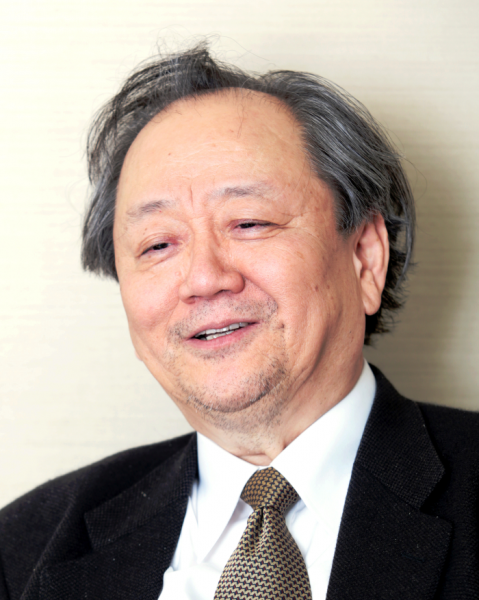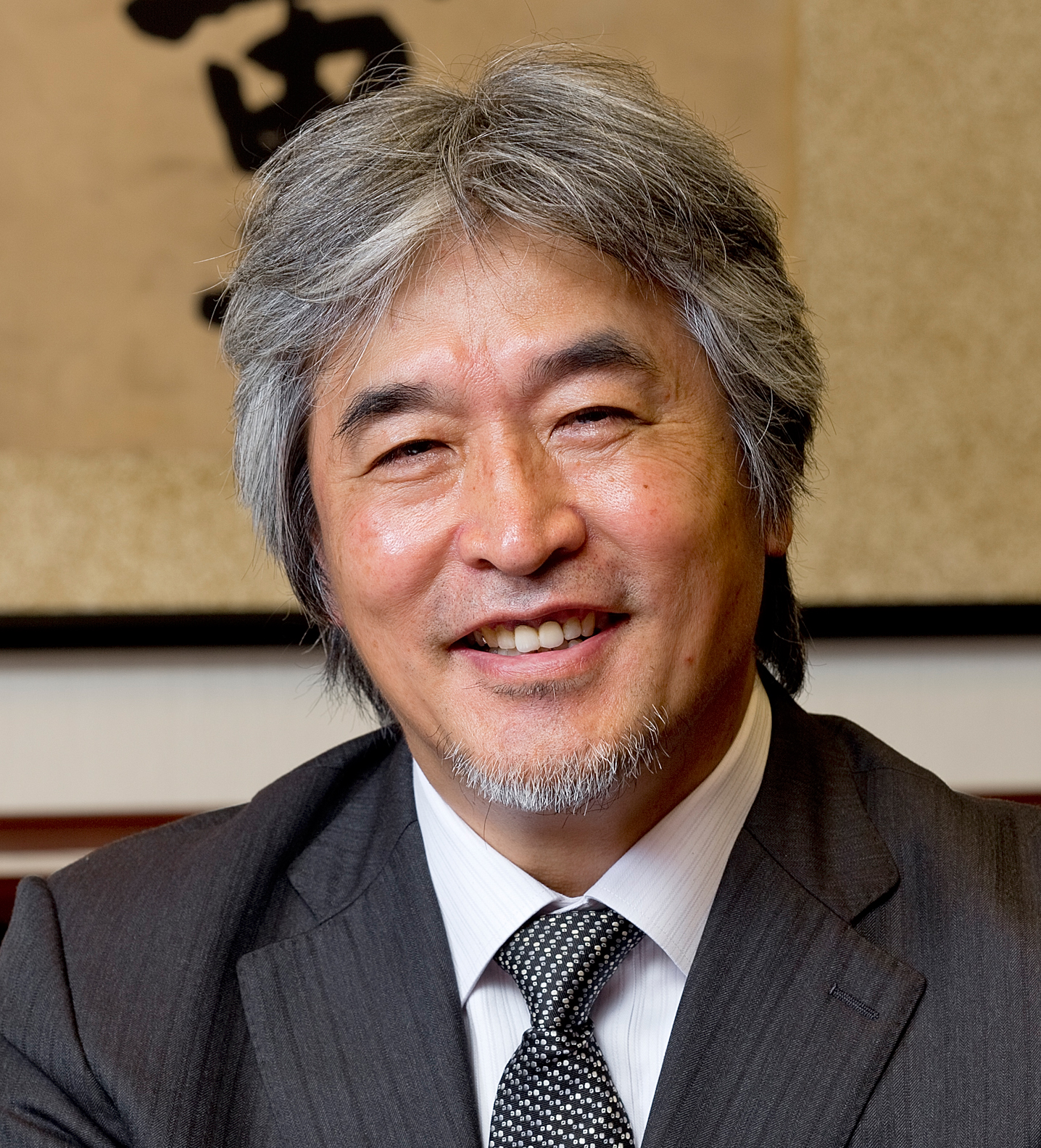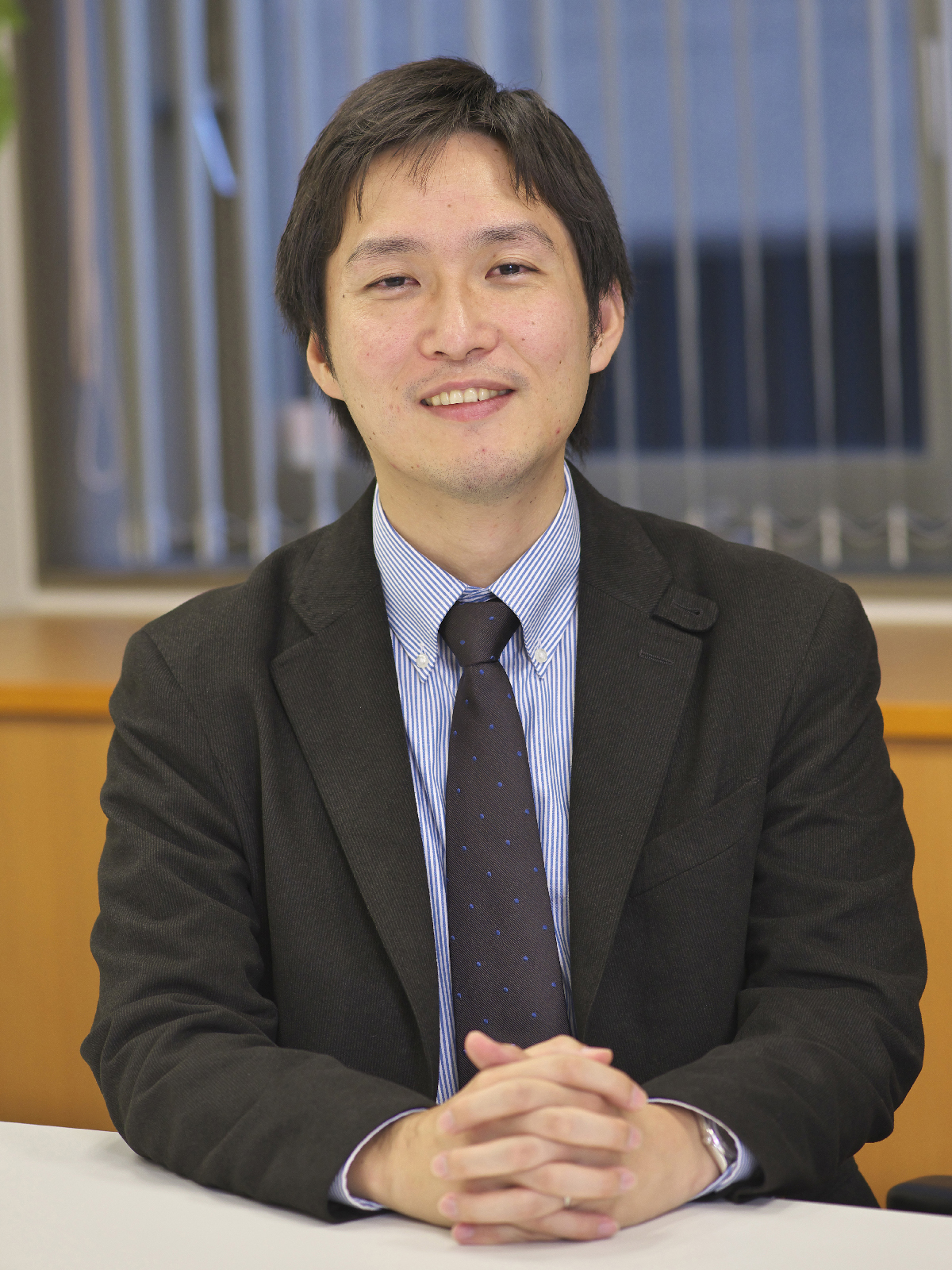Visiting the Offices of Large Companies Where the Retirement Age Has Been Extended ― Will the New Way of Working Bring Happiness to Companies and Employees?
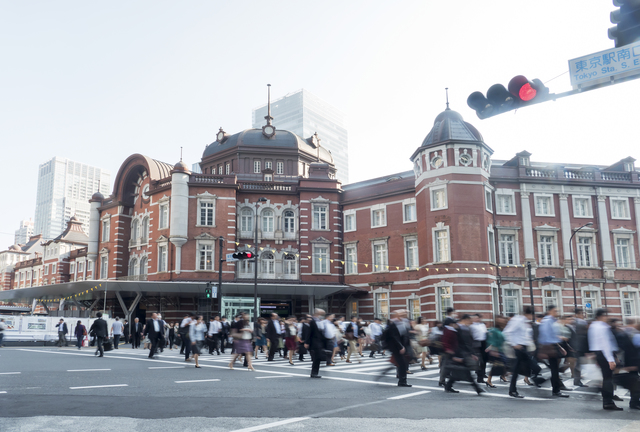
It is about a 10-minute drive north from the center of Shizuoka City to the Chiyoda branch of the Gusto chain of family restaurants. The branch faces a main road, but its location is not particularly good. This restaurant has achieved top results among some 3,000 Gusto, Jonathan’s, Aiya and other chain restaurants operated by Skylark Co., Ltd. nationwide, and it has received awards from the company again and again.
Mochizuki Isuzu, 63, began working at this family restaurant as a part-timer 36 years ago. Mochizuki has been the manager of this Gusto branch since 2009, when she became a permanent employee of Skylark.
“I tell our young staff members to phone me day or night if anything happens, because our store is open around the clock,” says Mochizuki. “They actually call me quite often. I don’t get angry, even if the reason for their call turns out to be trivial. If I got angry, they wouldn’t ask me for advice the next time something happened. That would ruin our restaurant. I do all kinds of jobs myself, including waiting tables, cooking food, cleaning and delivering food door-to-door, because staff members do not follow unless their restaurant manager takes action as their leader.”
This Gusto branch has just over 30 part-timers, including working people up to 68 years of age and senior high school students. Twelve or thirteen of them work every weekday. The number of on-duty workers rises to 15 or 16 on weekends. As the only permanent employee at the branch, Mochizuki interviews applicants, trains part-timers, prepares their work shifts, and gives them personal gifts on their birthdays.
The building of the Chiyoda branch is the same as the buildings of other Gusto chain restaurants. However, colorful flowers surround this restaurant. Flowers planted in high pots greet the eye as a visitor steps into the restaurant. “I do it for fun,” explains Mochizuki. “I spend my own money to do as I please because the restaurant budget that is available for these kinds of things is limited. You might think that chain restaurants are uniform and manual-based. But ideas and management efforts are sought in each region and each branch these days. We have many regular customers because we are in a residential area. I make it a habit to ask after their health if they look different from the day before.”
Skylark raised the retirement age for about 4,300 permanent employees and 80,000 part-timers to 65 in September 2015. The company also introduced a reemployment system for workers up to 70 years of age. These are progressive approaches in the family restaurant industry. Takahashi Shin-ichiro, a member of Skylark’s Human Resources Division, says that these initiatives were based on the idea that the first strike decides the battle.
“When our retirement age was 60, there were cases where housewives who had worked for us for a long time as part-timers began looking for their next job or left us as they reached their mid-50s,” recalls Takahashi. “It was a real waste to powerlessly lose skilled workers who could have stayed with us just because of the age limit. Securing the employment of part-timers was originally our main goal. The anticipated shortage of the young workforce in the future was an issue for us. We extended our retirement age to change the system for all our workers, including part-timers and permanent employees.”
“We wanted to give our senior workers peace of mind and make Skyland a workplace option for members of the generation moving toward that age group to enable them to keep working in a stable manner.”
Muscle Building to Maintain Physical Strength
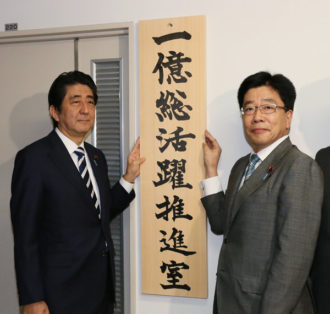
Government supporting a change in the way of working. The Secretariat for Promoting the Dynamic Engagement of All Citizens was established in October, 2015.
Photo: Cabinet Public Relations Office
Companies that have chosen to extend the retirement age to 65 are still rare.
The Act on Stabilization of Employment of Elderly Persons was revised in 2013. The revised Act made it compulsory for companies to employ workers wishing to remain at work until the age of 65, without exception. This legal revision was aimed at preventing the gap that could result from the retirement age of 60 and the starting age for the payment of employees’ old age pension, which was raised to 65.
There are three ways of dealing with this new legal requirement. Companies can re-employ workers (keep hiring them as fixed-term temporary employees or contract workers after their mandatory retirement), extend the retirement age, or abolish the retirement age (allow workers to keep working until they wish to retire). According to a survey on the state of elderly people’s employment conducted by the Ministry of Health, Labour and Welfare in June 2015, 81.7% of all surveyed companies adopted re-employment from among the three options. Companies that selected the extension of the retirement age accounted for 15.7%, and 2.6% chose the abolition of the retirement age.
Toko Kiichi, a chief researcher at Japan Productivity Center’s Employment System Research Center, reveals the current state of companies as follows:
“The extension or abolition of the retirement age gives companies the disadvantage of higher personnel expenses. There are companies that introduce a mandatory retirement age for executives, reduce wages for young employees or cut down on the employment of new workers in order to pay wages to senior employees.”
“In the meantime, re-employment, which involves resetting the working conditions and concluding a new employment contract, enables companies to keep costs such as health insurance and pension expenses down, in addition to stopping the payment of high salaries. For this reason, it is common practice among companies to re-employ workers who have reached the retirement age at salaries that are around 60% of what they received at the time of their retirement. The tendency to choose re-employment to avoid an increase in personnel expenses is stronger among large companies with a large number of employees.”
Salaries do not depend on age at Skylark, because the company has adopted a job rank system. The amount paid to a restaurant manager who joined the company less than three years ago and the amount paid to his or her counterpart with three more years to go before the retirement age can be the same at Skylark. Accordingly, the extension of the retirement age does not increase the costs for the company in any particular area.
What is unprecedented is that when it extended the retirement age, Skylark returned the status of workers in their 60s who had retired and were then re-employed to that of permanent employees. Mochizuki was one of the employees who made a return to the permanent workforce in this way.
“My annual income dropped sharply when I became a contract employee,” recalls Mochizuki. “But I didn’t quit because I love this company where I have worked all these years. I now receive a high evaluation and a salary that is too good for me. I’m planning to keep working for Skylark as a contract employee after reaching the retirement age for the second time at 65. It will be a test of my physical strength. I’m taking supplements and building my muscles at home (Mochizuki laughs). It’s not easy, but it’s fun.”
Arai Kazumi works for Daiwa House Industry Co., Ltd. He will turn 63 years old in November 2016. Arai belongs to the Quality Management Section within the Construction Department of Daiwa House Industry’s East Japan High- and Medium-Rise Technology Center.
“My main job is the interim inspection of rented apartments under construction,” says Arai. “I go to a construction site, walk around a building from the top floor down to the first floor, check numerous aspects with my own eyes and issue safety and quality instructions. We must detect inferior aspects, such as poor concrete pouring, at an early stage. It’s good exercise because there are a lot of aspects to check (Arai laughs).”
Daiwa House Industry’s executives have two courses to choose from when they reach the retirement age of 60. The first option is the “staying-on-the job course.” Those who choose this course take charge of sales, design, administration and other duties on the front lines. The second choice is the “senior mentor” course. Those who pick this course play the role of a senior mentor who passes cultivated personal contacts, experience and knowledge down to younger colleagues. The required qualifications to become senior mentors include work experience as a line leader and a recommendation by an office manager or a division manager. There is also a quota set for them, which is up to 10% of employees 61 years old or older. These conditions make appointment to the post difficult. In addition to a salary, each senior mentor receives an allowance amounting to 50,000 yen a month.
Arai is a senior mentor. He has worked exclusively in the construction industry since graduating from a vocational school at the age of 20. Arai joined Daiwa House Industry mid-career when he was 50 years old.
“I was the manager of a department that oversees construction when I was 60,” says Arai. “I had about 140 subordinates at the time. I wanted to visit construction sites, but such an opportunity was hard to find at the time. I wanted to train my subordinates, but I couldn’t give them detailed instructions. Now I can go to construction sites freely, stick with the young employees and give them instructions. It’s a worthwhile job.”
Specially Appointed Department Manager as the Title
Daiwa House Industry made the switch from re-employment to the extension of the retirement age in 2013.
“The motivation of working people declined under the system of re-employment. That was our problem during the period when we re-employed retired workers,” recalls Kikuoka Daisuke, the deputy general manager of the Personnel Affairs Department at Daiwa House Industry’s Tokyo Head Office.
“Wages were one of the reasons for their decline in motivation,” explains Kikuoka. “Re-employed people received a salary that was about 60 percent of what they had received before retirement. Salaries decreased to about half for re-employed workers who had previously held management positions.”
“No sense of solidarity with the regular full-time service workers and unclear roles were other reasons,” adds Kikuoka. “The company could not give them responsibilities, and the workers didn’t know what kind of work they should do. There was constraint on both sides. Our personnel expenses grew with the extension of the retirement age, but we think the increase is OK since it functions as an investment in our growth.”
Arai has no subordinates now. The title printed on his business card is “Specially Appointed Department Manager.” That is the case because a title is externally convenient, and people calling him a department manager as they used to provides him with motivation. Deeply tanned Arai flies around about 70 sites in the district of his responsibility centered on Tokyo and its suburbs during busy periods. He seems cheerful, though.
“I’m happy now because I’m performing a job I’ve always wanted to do,” explains Arai. “I think the development of a system that enables elderly people to put the career they have built to practical use is essential to their employment. I don’t think that elderly people can keep working for a long time solely in return for the money they receive. They need the sense of satisfaction that comes from displaying their capabilities.”
Daiwa House Industry offers a system of re-employment that is renewable every year, called the Active Aging System, to workers older than the retirement age of 65. There is no upper age limit set for participants in the Active Aging System. It is possible for the participants to remain in active service throughout their lives. Arai, who lives temporarily in the Tokyo metropolitan area from Monday to Friday, away from his own house in Gunma Prefecture, is now thinking about retiring from work, however.
“The extension of the retirement age delighted my wife,” remembers Arai. “She asked me to work hard when she learned the news (Arai laughs). But our two children had already become independent. I’m thinking about retiring from work and traveling with my wife or growing vegetables with her after the age of 65. I enjoy working, but I’ve always lived away from my family since the days when I was the manager of offices in charge of various construction sites.”
Suntory Holdings Ltd. also decided to extend the retirement age out of its desire to give active senior workers a chance to display their abilities without reserve.
When Suntory Holdings interviewed its re-employed senior workers, they expressed opinions such as, “I felt like a lonely odd man out when I was re-employed, even though I had always worked as a member of a group” and “I would like the company to have a system that brings out our tenacity a little more.”
Sato Minoru, who worked for Suntory Publicity Service Ltd., a Suntory Holdings affiliate, felt the same.
“There were seniors around who showed a decline in motivation after their re-employment upon reaching retirement age,” remembers Sato. “I thought that was a shame.”
However, Sato says that he had mixed feelings himself when his company decided to extend the retirement age. He was 59 years old at that point.
“I felt like a sprinter in the 100-meter dash,” recalls Sato. “Whether to breast the tape spectacularly or not aside, I was already in a place that was only five meters from the goal. Then, suddenly, the goal moved away from me. That’s how I felt (Sato laughs). But, on second thought, I had not experienced a decline in physical strength or willpower. I could still contribute to my company. I found our system acceptable, including compensation equaling 60% to 70% of the salary at the age of 60. At home, my wife is happy with the system too. It’s not so much a question of money for her. She says, ‘It’s better than watching you idling your time away at home’ (Sato laughs again).”
Sato moved to Suntory Publicity Service in 2009 after heading a section in the International Strategy Department of the Suntory Holdings Head Office and managing a sales division at its affiliate handling wine. Suntory Publicity Service started out with guided tours of beer breweries. The company has since expanded its operations to include comprehensive tours of cultural facilities and large-scale commercial facilities such as the Tokyo Skytree.
Sato says that he retired from the position of manager at the age of 60, but the details of his tasks other than management duties have not changed that much. His current title is General Manager of the Second Public Relations Division. In addition to taking charge of the employment and training of about 150 predominantly female staff members working at the respective facilities, Sato gathers information such as facility characteristics and client requirements through inquiries and adjusting small details.
“Our staff members develop concerns in the course of their contact with customers,” notes Sato. “Problems also emerge in terms of cooperation between team members. Supporting them on such occasions is part of my job as well. I have been able to put my past experiences to practical use in these tasks. I have a real feeling that my interests are shifting more and more toward people as I age. Junior workers younger than my own children count on my support in my current job. I find the job rewarding.”
Kanda Hideki, General Manager of the Personnel Affairs Division of Suntory Holdings, provides the following explanation.
“After extending the retirement age, we found that senior employees dislike special consideration and cautious treatment, not management by a younger superior. We are linking performance evaluation with achievements as well, because it is essential to link evaluations with salaries from the viewpoint of rewards for work.”
Suntory Holdings considers titles important too. The company enables senior employees to use titles such as “Specially Appointed Section Head” and “Specially Appointed Department Manager.” How senior employees are referred to within the company is said to remain the same regardless of their age because all workers at Suntory Holdings, including superiors, have traditionally been called Mr. or Ms. So-and-So, without reference to their title. Sato will reach retirement age three years from now.
“Looking at elderly people working energetically, I wonder whether they are able to work because they are energetic or whether they are energetic because they are working,” says Sato. “I feel like working after the retirement age of 65. At the same time, I feel like celebrating my life outside work. It’s a difficult question.”
Going Back to the Field and Doing Favorite Work
Koyama Akira works as an event planner at the Monozukuri Kan by YKK, an event venue that YKK Corporation, a fastener and housing construction materials manufacturer, established next to its head office in Akihabara, Tokyo. He is now 61 years old.
One of the objectives of this facility is to offer visitors opportunities to learn the history and mechanisms of fasters and other YKK products while communicating the fun aspect of manufacturing to them through handicraft and carpentry workshops and exhibitions. Another goal for the facility is to contribute to the regional revitalization of the host communities of Tokyo’s Chiyoda Ward and Taito Ward.
Koyama is primarily in charge of the latter mission. He performs tasks including event planning.
“The history of fasteners is surprisingly short,” explains Koyama. “They were invented in the United States in 1891 as substitutes for shoestrings. They became popular after the United States Air Force started using them on flight jackets for its servicemen around 1920.”
Koyama’s tone warms up as he explains the exhibits within the building. He worked overseas for 20 years until returning to Japan about 10 years ago. Koyama says he carried out work to embed YKK products in each region.
“We brought buttons and fasteners from Japan, marketed them, prepared the conditions necessary for their sale, trained people, and proposed local production when it was necessary,” recalls Koyama. “My last overseas post was in Indonesia, where I took charge of operations in the entire ASEAN region. After returning to Japan, I was mainly involved in the development of the logistics, construction and medical service markets, asking how people could use our fastening products in new markets.”
YKK transferred Koyama to the Monozukuri Kan by YKK to coincide with the facility’s opening in September 2015.
“My salary became smaller, but I understand that the decrease was not due to my age, but due to this site-specific job,” says Koyama. “I’m proposing things I want to do, involving younger coworkers and doing those things freely as I please. Many people around me say that when they reach my age, they want to go back to the field and perform their favorite job, rather than working as a manager.”
YKK declared that the extension of the retirement age was an “interim measure toward the abolition of the retirement age” when it took the step in 2012. Kameyama Hideo, General Manager of the company’s Human Resources Department, provides the following explanation.
“YKK is working to achieve a genuinely fair personnel system without bias due to age, gender, academic background or nationality. This means that we give suitable roles to people who are able to do great things. There is no retirement age for our executives. We are also thinking about employing people 60 years old and over as ready workers who are able to contribute to the company, instead of hiring them from a welfare perspective.”
According to YKK, a personnel system that assumes that abilities change before and after the age of 60 is not a fair one. For that reason, workers in their 60s can rise in status and receive a pay raise at the company. The opposite treatment is also possible for the company’s employees when they are assessed as lacking the ability to perform their assigned roles. YKK is undertaking internal studies regarding abolishing the retirement age.
However, Koyama says with a smile, “I’ve decided that I will stop working when I turn 65 years old. I can’t tell you right now what I will do after that.” Koyama already seems to have a post-retirement plan in mind.
McDonald’s Holdings Company (Japan), Ltd. abolished the retirement age ahead of other companies. In 2006, McDonald’s Holdings Japan declared that opportunities for making contributions to the company should not be lost because of factors unrelated to individual abilities, such as age and gender.
Six years after that declaration, however, in 2012, McDonald’s Holdings Japan revived the retirement age of 60 and adopted a re-employment system for workers up to 65 years of age. What happened to the company? Kanitani Kenji, General Manager of the Public Relations Department within the Communications Division of McDonald’s Holdings Japan, reflects as follows.
“We anticipated an environment that would enable our veteran employees to display their abilities and transfer their know-how to develop their subordinates. But we could not say that this environment had developed after five years of efforts. Having no retirement age made veterans enthusiastic about achieving good results in their respective jobs, but they didn’t show a positive attitude toward training their successors.”
“A mentality based on many years spent under a seniority system also remained within the company. It may have been a little too early to create the flow of simultaneous self-growth, subordinate training and corporate development.”
“I don’t think the abolition of the retirement age was a mistake in itself, though. Those five years were a period that was necessary for trial and error. We don’t view the abolition of the retirement age as a failure.”
McDonald’s Holdings Japan made the transition from seniority-based wages to job-based salaries two years before the abolition of the retirement age. More than 10 years later, job-based salaries are now established within the company. The system has given birth to department managers in their 30s. At the same time, it has also led to the emergence of re-employed department managers 60 years old and over.
Tanita’s Original Re-Employment System
Companies that have switched from re-employment to retirement age extension cite difficulty in personal relationships that former superiors create by remaining in their places of work as temporary employees as a reason for the switch. Tanita Corporation, a company known for body composition monitors, other health meters and its company cafeteria, solved this problem with an original re-employment system.
“Switching is difficult for both former managers who have been re-employed and placed under the management of their juniors and those juniors themselves,” notes Kon Masato, President of Tanita Comprehensive Research Center Corporation. “We discontinued our system of re-employment by the Head Office and reshaped it into a system of transfer to another company in order to break off such personal connections.”
In 2011, Tanita began transferring its employees who reached the retirement age of 60 to Tanita Comprehensive Research Center, its subsidiary. Many of these people continue to work in the same office under their new employment status of temporary employees dispatched by another company.
They go to Tanita Comprehensive Research Center located within the Head Office of Tanita to work in the morning and head to their respective dispatched offices with a laptop computer and other tools in hand. This practice is based on a rule stipulated in the Act for Securing the Proper Operation of Worker Dispatching Undertakings and Improved Working Conditions for Dispatched Workers. It is said to help them switch their way of thinking as well. The tasks they perform are centered around training for young workers. Their relationships with Tanita are businesslike, however. Tanita Comprehensive Research Center assumes cases where Tanita notifies it of its decision against contract renewal.
“In such cases, Tanita Comprehensive Research Center asks the employees concerned to come over and have discussions with it,” explains Kon. “We deal with these cases by reassigning the employees to work within our company. They are former Tanita employees, but we are doing things strictly because business is business. Tanita employees at the office concerned can consult us, instead of the employees concerned themselves, when there is a problem with them. That is another characteristic of this system.”
Products from Tanita’s 93-year history are on display at the Tanita Museum located within the Head Office of Tanita. Yokouchi Tomiyoshi of Tanita Comprehensive Research Center has contributed his ideas for exhibits and provided explanations to visitors as the facility’s curator since it opened in 2011.
“I was the manager of the Design Office when I reached the retirement age of 58 for executives,” notes Yokouchi. “It was fun to take charge of product and package designs. I think it’s good to start over again with a transfer. Supplying information about products with which I had been involved for many years to people who knew nothing was a delightful job for me. There were colleagues who hated the salary decrease after the age of 60 and quit with a new ambition. But I thought it was fair enough, because I wanted to return the favor to the company that had allowed me to work (Yokouchi laughs).”
Yokouchi joined Tanita when he was 18 years old. He reportedly studied design at a vocational school that he attended at night. Yokouchi, who has been re-employed repeatedly as an exceptional case, is now 67 years old.
“I am going to retire this coming December,” reveals Yokouchi. “I will feel a little empty because I have enjoyed working for this company for 50 years. I’m thinking about looking for my next job now. Doing something will give me a good feeling of tension, even if it only means earning a little extra money three days a week or so.”
President Kon of Tanita Comprehensive Research Center provides the following observation.
“How to work after the age of 60 is up to each individual. That’s how Tanita thinks. You can keep working hard. Or you can work six hours a day as a part-timer if you don’t want to ride in a packed train. Based on this idea, we are offering our workers two status options – as a full-timer with a fixed salary or as a part-timer with an hourly wage – at the point of their transfer to Tanita Comprehensive Research Center.”
Horie Naoko, Senior Chief Researcher at the Policy Research Department of Mizuho Research Institute Ltd., provides the following explanation.
“Many companies introduce the system passively based on the law. We can say that companies that switch to the extension of the retirement age have a tendency to take a new look at senior people as willing workers. More and more companies will extend the retirement age to secure personnel in the future when the young labor force shrinks.”
In fact, large companies planning to extend the retirement age expressed their plan to stress a results-oriented approach and their expectations for improved company-wide employee performance with the switchover.
Honda Motor Co., Ltd. has officially decided to extend the retirement age for about 40,000 Honda Group employees in Japan. The company will introduce the extension in the next fiscal year. Odaka Kazuhiro, Chief Operating Officer for Honda’s Business Support Operations, describes developments as follows.
“Under the re-employment system up to the present, salaries drop to about half of their pre-retirement levels. Overseas postings are not possible. Working conditions have been restricted as a result. From now on, the wage standard will be 80% of the salary at the age of 60. The places of work will expand as well.”
Odaka says that these changes will be part of the comprehensive revisions of working conditions. Honda will adopt the new retirement age of 60 for executives, reexamine its salary structure and expand its results-based differentials. The company plans to upgrade childcare and nursing care support for the working generation. However, Odaka predicts that its total annual personnel expenditure will not change because his company will take a second look at allowances for overtime work and domestic business trips.
Meiji Yasuda Life Insurance Company has decided to extend the retirement age in 2019 as well.
“We adopted equal pay for the same job last year to base treatment entirely on the sizes of roles and the degree of success, instead of titles and ages, in an attempt to urge all employees to work enthusiastically,” says Sato Mitsunobu from Meiji Yasuda Life Insurance’s Human Resources Department, explaining the reason for the switch. “The extension of the retirement age is an extension of this way of thinking.”
A system for supplying public subsidies to companies that extended the retirement age to 66 or above was launched in April 2016. The government is studying the idea of making employment compulsory until 70 years of age. There have also been discussions about raising the starting age for pension payments to 70.
“Most of the companies now adopting the extension of the retirement age are small and medium-sized ones that are having a hard time securing personnel, or large companies with strong results,” says Enomoto Masakazu, a management and personnel affairs consultant. “But I think the switchover from re-employment will accelerate in the future. Workers will be asked to work in corresponding ways in exchange for guaranteed employment. Moves toward the strict assessment of senior workers will advance quietly as well. Moves for their employment will shift from welfare to competition and a results-oriented approach.”
From now on, senior people will need the ability to clearly ascertain whether or not the personnel system of the extension of the retirement age agrees with the way they wish to live the latter half of their life.
Translated from “Dailogyo teinen encho no shokuba wo yuku (Visiting the Offices of Large Companies Where the Retirement Age Has Been Extended.),” Bungeishunju, November 2016, pp. 202-210. (Courtesy of Bungeishunju Ltd.) [November 2016]

